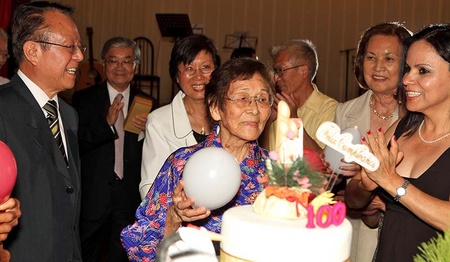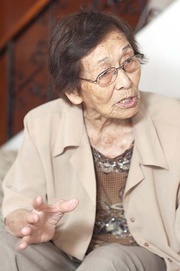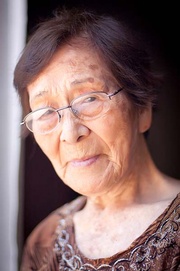Making it to your 100th birthday is no small miracle. To turn 100 years old with your memory intact and a sense of humor, not to mention in good physical health, if that isn’t a miracle, it’s pretty close to it.
Tsuyo Toyama celebrated a century of life in January. She arrived not as a marathon runner who crosses the finish line exhausted, but as the long-distance runner who still has enough in her for a few more races.
Relatives from Japan, Brazil, Turkey, and Costa Rica arrived in Lima, Peru, to celebrate her 100th birthday. Her son, Takeshi, who lives in Okinawa, brought her several kimonos that she wore to her party.
“I was very content,” Tsuyo obaachan 1 recalls. She expressed some thoughts at her party, feelings that she had written down that summarize her 100 years, words emphasizing the highlights of her life; for example, how she arrived in Peru from her native town of Okinawa, or the opportunity she had to meet Emperor Akihito when he visited Lima as heir apparent to the Japanese throne.
Difficult times
Tsuyo Toyama arrived in Peru on 17 November 1930 when she was only nineteen years old. It was a time of political instability and coup d’états. She married Zensei Toyama at that time, and they remained married for sixty-five years until he passed away.
Upon reviewing her life, it is impossible to forget the war. It was a terrible time.] Looting, earthquakes, deportations. “We suffered a lot,” she remembers. She believed that they would not survive, that the end was just around the corner.
Nevertheless, even in the worst circumstances, she discovered the goodness of several Peruvians who protected them. “Perujin2 were very good, they defended us,” Tsuyo comments.
The Toyama family had a restaurant in the La Victoria district of the city. Thousands of vandals looted Japanese businesses on 13 May 1940. Their establishment was spared, however, because the property owner climbed to the top of the roof and waved a Peruvian flag, shouting “We are Peruvians here, no need to attack us!” The crowd dispersed.
Less than two weeks later, on May 24th, an earthquake rocked Lima. There were people who believed that the quake was divine punishment for the aggression committed against the Japanese community.
Tsuyo obaachan smiled when she remembered that the women in the neighborhood were annoyed at their husbands, blaming them for the earthquake because they hadn’t done enough to prevent the looting of Japanese businesses, and that they defended themselves from such rebuke (“We didn’t do anything”).
In order to avoid deportation to the concentration camps in the United States, she recalls that in several Japanese homes they had established a signal for the head of the family when he returned home: if the front door light was on, he should keep on walking for a while; if the light was out, the coast was clear and he could enter the house.
Six decades have passed since then, but one doesn’t forget so easily such experiences. “Senso wa kowai desu 3 ” Tsuyo obaachan recalls.
The JPCC and the Royal Family
Tsuyo Toyama saw first-hand the construction of the Japanese-Peruvian Cultural Center. Her husband, the former president of the Japanese Society, was one of its founders. There was a series of events to mark the grand opening of the center, which prompted Toyama’s participation, including the visit by members of the Japanese royal family, Akihito and Michiko, who came to Lima in 1967 to attend the inauguration.
They went to the government palace where President Fernando Belaunde welcomed the royal family. Tsuyo obaachan confesses that when the presidential staff announced the arrival of Mr. and Mrs. Toyama, she felt very important.
The dining hall was immense, she recalls, and there was a lot of food. When a foreign ambassador told her that Princess Michiko was nice and had nice skin—like that of porcelain—she appreciated his praise of the Japanese princess.
One member of the royal entourage left briefly with the issei 4 who were in attendance, asking them how long they had lived in Peru. Many responded forty or fifty years. His interpreter invited them to return to Japan, assuring them that Japan had changed dramatically since they left for Peru.
It all seemed like a dream to Tsuyo: being in the government palace, participating in such a regal affair, meeting members of the Japanese royal family, not to mention the Peruvian president. “I felt like I was in a movie,” Tsuyo recalls.
Nevertheless, Tsuyo obaachan recalls quite proudly that magical moment she was privileged to experience. She recounts the events with simplicity and even smiles when she remembers how handsome the men appeared in their tuxedos, particularly since they were not accostumed to dressing up so formally.
It wasn’t the only time that she had the opportunity to meet a member of the royal family. In 2009, during the festivities surrounding the 110th anniversary of Japanese immigration to Peru, she was able to exchange pleasantries with Prince Hitachi, brother of Emperor Akihito, in the Japanese-Peruvian Cultural Center (JPCC).
Tsuyo obaachan remembered that the emperor had attended the inauguration of the cultural center, and she asked Prince Hitachi if he would tell his brother that the building was “very nice.”
Her husband was not present at that time, however; he had died in 1995. The day that he passed away, he had gone to a bookstore in order to buy a copy of Peruvian Traditions, by Ricardo Palma, and he gave it as a gift to one of his nephews. When he returned home he went to sleep and never woke up, dying peacefully.
NOTES:
1. Grandmother
2. Peruvian
3. “War scares me”
4. Japanese immigrants (first generation)
* This article was published thanks to an agreement between the Japanese-Peruvian Association and the Discover Nikkei Project. It was appeared originally in the journal Kaikan, volume 54, February 2011, and adapted for Discover Nikkei.
© 2011 Asociación Peruano Japonesa © 2011 Fotos: Asociación Peruano Japonesa / Álvaro Uematsu / Archivo de la familia Toyama












